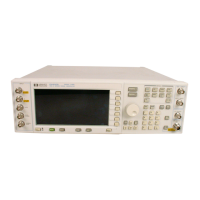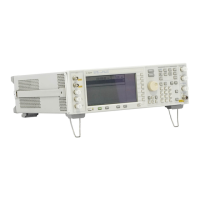c. Set
the auto
ll start
frequency to
15 MHz:
4
PRIOR
5
N
N
N
N
N
N
N
N
N
NN
NN
NN
NN
NN
NN
NN
N
N
N
N
N
N
N
N
N
N
N
NN
NN
NN
NN
NN
NN
N
Auto
Fill
Start
4
15
5
4
MHz
5
d. Set
the
auto
ll
incremen
t
to
10
MHz:
N
N
N
N
N
N
N
N
N
N
NN
NN
NN
NN
NN
NN
NN
N
N
N
N
N
N
N
N
N
N
N
NN
NN
NN
NN
N
Auto
Fill
Incr
4
10
5
4
MHz
5
3.
On
the
p
o
w
er
meter,
load
the
calibration factors
for the
po
wer
sensor.
a.
Zero
and
calibrate
the
po
wer
meter/sensor.
b. Connect
the p
o
w
er
sensor
to
the
syn
thesizer's
RF
OUTPUT
as
sho
wn
in
Figure
2-6
.
4.
Set
the
syn
thesizer
to
measure
the
p
o
w
er
correction v
alues and
generate a
new user
atness
arra
y
for
the frequency
range en
tered. Press:
N
N
N
N
N
N
N
N
N
N
N
N
NN
NN
NN
NN
N
N
N
N
N
N
N
N
N
N
N
N
N
N
N
N
N
NN
NN
Mtr
Meas
Menu
N
N
N
N
N
N
N
N
N
N
N
N
NN
NN
NN
NN
N
N
N
N
N
N
N
N
N
N
N
N
N
N
N
N
N
NN
NN
NN
NN
N
N
N
N
N
Measure
Corr
All
When
the
atness
correction
arra
y
is
completed,
the
men
u
is
returned.
5.
Scroll
through
the
user
atness
correction v
alues using
the up/do
wn
arro
w
k
eys.
Note
the
maximum
and
minim
um
correction
v
alues.
The
dierence
b
et
w
een
them
is
the
p
o
w
er
atness
measuremen
t.
Record
the
v
alue
on
the
test
record
and
compare
the v
alue to
the
sp
ecication.
6.
Delete
the atness
correction
arra
y
.
Press:
PO
WER
4
MENU
5
N
N
N
N
N
N
N
N
N
N
N
NN
N
N
N
N
N
N
N
N
N
N
N
N
N
N
N
N
N
N
N
N
N
N
N
NN
Fltness
Menu
N
N
N
N
N
N
N
N
N
N
N
NN
N
N
N
N
N
N
N
N
N
N
N
N
N
N
N
N
N
N
N
N
N
N
Delete
Menu
N
N
N
N
N
N
N
N
N
N
N
NN
N
N
N
N
N
N
N
N
N
N
N
N
N
N
N
N
N
N
N
Delete
All
High
Band
P
o
w
er
Flatness
7.
With
the
appropriate
p
o
w
er
sensor
for
this
frequency
range, rep
eat steps
2
through
6
for:
A
20
GHz
stop
frequency
.
A
2.05
GHz
start frequency
.
A
100
MHz
incremen
t.
Millimeter
Band P
o
w
er
Flatness
>
20
GHz
and
40
GHz
Disr
e
gar
d
if
b
eyond
your
synthesizer's
c
ap
ability.
8.
With
the
appropriate
p
o
wer
sensor for
this
frequency
range,
rep
eat
steps
2
through
6
for:
A
40
GHz
stop
frequency
(for
83630B
/L
only
,
set
to
26.5
GHz).
A
20.05
GHz
start
frequency
.
A
100
MHz incremen
t.
Millimeter
Band
P
o
w
er
Flatness
>
40
GHz
Disr
e
gar
d
if
b
eyond
your
synthesizer's
c
ap
ability.
9. With the appropriate p o
wer sensor for this
frequency range, repeat steps 2 through 6 for:
A
50 GHz stop frequency
.
A 40.05 GHz start frequency
.
A 100 MHz incremen
t.
Related Adjustments
Power Flatness
In Case of Difficulty
1. The p ower meter must b e an HP/Agilent 437B.
2. The correct calibration factors for the power sensor must be loaded.
3. Refer to the
Agilent Technologies 8360 B-Series Swept Signal Generator/8360 L-Series
Swept CW Generator Troubleshooting Guide
.
Agilent 8360 Performance Tests
Power Flatness
2-27

